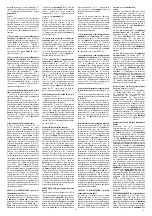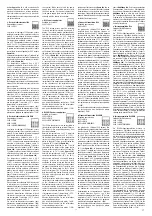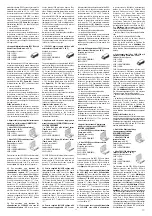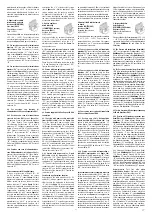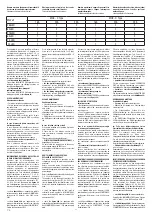
22
Terra unipolare separato, vedere
figura 36a/36b
per box con driver interni o vedere
figura 37
-
38
-
39
-
40
per box con driver esterni). Far
passare il cavo di alimentazione bipolare “C2”
(Fase, Neutro, vedere
figura
15
) attraverso il
pressacavo “G1” e sotto il serracavo “S1”. Per
versione con tensione di alimentazione da 230V,
collegare i conduttori di Fase e Neutro ai poli L e
N del morsetto “M1”. Per versione con tensione
di alimentazione bifase da 400V, collegare i
conduttori di Fase 1 e Fase 2 ai poli L1 e L2
del morsetto “M1”.Serrare il serracavo “S1”.
Per il collegamento del cavo di terra unipolare
allentare la ghiera “Y” del pressacavo “G3” ed
estrarre il relativo tappo. Per cavi con diametro ≤
8mm utilizzare apposito gommino ridotto fornito
in dotazione nel sacchetto presente all’interno
della scatola dell’apparecchio (vedere
figura
42
). Far passare il cavo di Terra unipolare “C5”
(vedere
figura
18
) attraverso il pressacavo “G3”
e sotto il serracavo “S3”.
Collegare il conduttore di Terra al polo di Terra
del morsetto “M1”. Serrare il serracavo “S3”.
3.3 Per versione con cavo di alimentazione
230V e cavo DALI
3.3.1 Versione con cavo di alimentazione
separato dal cavo DALI
(vedere
figure
36a
per box con driver interni o vedere
figura 37
per box con driver esterni). Far passare il cavo
di alimentazione tripolare “C1” (Fase, Neutro,
Terra, vedere
figura
14
) attraverso il pressacavo
“G1” e sotto il serracavo “S1”. Collegare i
conduttori di Fase, Neutro e Terra ai poli L, N
e Terra del morsetto “M1”. Serrare il serracavo
“S1”. Allentare la ghiera “Y” del pressacavo
“G2” ed estrarre il relativo tappo. Far passare
il cavo di controllo DALI bipolare “C3” (DA, DA,
vedere
figura
16
) attraverso il pressacavo “G2”
e sotto il serracavo “S2”. Collegare i conduttori
del cavo di controllo DALI ai poli DA/DA del
morsetto “M2”. Serrare il serracavo “S2”.
3.3.2 Versione con cavo di alimentazione
+ cavo DALI pentapolare
(vedere
figure
36a
per box con driver interni o vedere
figura
37
per box con driver esterni) Far passare il cavo
pentapolare “C4” (Fase, Neutro, Terra, DA, DA,
vedere
figura
17
) attraverso il pressacavo “G1”
e sotto il serracavo “S1”. Collegare i conduttori
di Fase, Neutro e Terra ai poli L, N e Terra nel
morsetto “M1” e i conduttori DALI ai poli DA/DA
del morsetto “M2”. Serrare il serracavo “S1”.
3.4 Per versione con cavo di alimentazione
e cavo DMX separato (box FAEL con driver
esterni e Tamb. max. = 50°C)
(vedere
figura
38
per versione 230V o vedere
figura
40
per
versione 400V) Per il collegamento del cavo di
alimentazione vale quanto detto al punto 3.1
per cavo tripolare. Per il collegamento del cavo
di alimentazione vale quanto detto al punto
3.2 per cavo bi terra separata. Per il
collegamento del cavo DMX l’apparecchio viene
fornito con connettori maschio “W” (connettore
maschio_OUT) e femmina “K” (connettore
femmina_IN) tipo XLR già montati ed in uscita
dall’apparecchio; altri due connettori maschio e
femmina tipo XLR vengono forniti in un sacchetto.
Per il collegamento alla linea DMX occorre
montare i connettori presenti nel sacchetto sui
cavi di collegamento (non forniti da FAEL) tra
gli apparecchi eseguendo una saldatura come
in
figura
45
. Per la protezione dei cavi DMX è
opportuno inserire tali cavi in apposite tubazioni
di protezione separate dal cavo di potenza.
Utilizzare un cavo DMX ad impedenza costante
a 2 poli interni schermati, specifico per la
connessione di apparecchiature che utilizzano il
protocollo DMX512 con impedenza nominale di
120 Ohm. Scegliere un cavo con guaina esterna
consona alle temperature ambientali della zona
di installazione.
Parte comune per tutti i capitoli sopra
In base al pressacavo utilizzato (G1, G2 e/o G3):
verificare il serraggio, con chiave inglese, del
corpo “X” (vedere
figura
13
) del/i pressacavo/i
applicando un momento torcente di 4Nm;
serrare con cura e a fondo, con chiave inglese, la
ghiera “Y” (vedere
figura
13
) del/i pressacavo/i
applicando un momento torcente di 3.5Nm. Una
volta collegato elettricamente l’apparecchio,
richiudere il vano accessori elettrici serrando
le 3 viti V” (vedere
figure
3a
-
3b
) in acciaio
inox applicando un momento torcente di
5.2Nm assicurandosi che la guarnizione sia
separated single-pole Ground cable, check the
figures
36a/36b
for internal driver box type or
figures
37
-
38
-
39
-
40
for external driver box
type). Pass the two-pole power supply cable
“C2”(Phase, Neutral; check the
figure 15
)
through the cable gland “G1” and beneath
the cable clamp “S1”. As regards the version
supplied 230V voltage, connect the Phase
and Neutral conductors to the L and N poles
of the terminal “M1”. As regards the version
supplied 400V voltage, connect the Phase 1
and Phase 2 conductors to the L1 and L2 poles
of the terminal “M1”. Tighten the cable clamp
“S1”. To connect the cable to the single-pole
grounding cable, loosen the nut “Y” of the cable
gland “G3” and remove the related plug. For
cables having diameter ≤ 8mm, use a suitable
grommet supplied in the bag fitted inside the
appliance housing (check the
figure 42
). Pass
the single-pole Ground cable “C5” (check the
figure
18
) through the cable gland “G3” and
under the cable clamp “S3”. Connect the
Ground conductor to the Ground pole of the
terminal “M1”. Tighten the cable clamp “S3”.
3.3 Version with 230V power cable and DALI
cable
3.3.1 Version with the power cable separated
from the DALI cable
(check the
figure
36a
for internal driver box type or
figure 37
for
external driver box type). Pass the three-pole
power supply cable “C1”(Phase, Neutral,
Ground; check the
figure
14
) through the
cable gland “G1” and beneath the cable clamp
“S1”. Connect the Phase, Neutral and Ground
conductors to the L, N and Ground poles of the
terminal “M1”. Tighten the cable clamp “S1”.
Loosen the nut “Y” of the cable gland “G2”
and remove the related plug. Pass the two-
pole control cable DALI “C3” (DA, DA, check
the
figure
16
) through the cable gland “G2”
and beneath the cable clamp “S2”. Connect
the conductors of the DALI control cable to the
DA/DA poles of the terminal “M2”. Tighten the
cable clamp “S2”.
3.3.2 Version with power cable + 5-pole
DALI cable
(check the
figure
36a
for internal
driver box type or
figure
37
for external driver
box type) Pass the 5-pole cable “C4” (Phase,
Neutral, Ground, DA, DA, check the
figure
17
)
through the cable gland “G1” and beneath the
cable clamp “S1”. Connect the Phase, Neutral
and Ground conductors to the L, N and Ground
poles on the terminal “M1” and the DALI
conductors to the DA/DA poles of the terminal
“M2”. Tighten the cable clamp “S1”.
3.4 Version with power cable and separated
DMX cable
(FAEL box with external drivers
and Tamb. max. = 50°C) (check the
figure
38
for the 230V version or the
figure
40
for the
400V version) Follow the indications related to
the three-pole cable provided in the paragraph
3.1 to connect the power cable. Follow the
indications related to the two-pole cable +
separated ground provided in the paragraph
3.2 to connect the power cable. The appliance
features XLR type male “W” (male connector_
OUT) and female “K” (female connector_IN)
connectors already mounted, available at the
appliance output, meant for the connection
of the DMX cable; other two XLR type male
and female connectors are supplied in a bag.
For the connection to the DMX line, fit on the
connection cables (not supplied by FAEL),
between appliances, the connectors supplied
in the bag and seal as shown in
figure
45
. To
protect the DMX cables it is recommended to
have them inserted in special protection pipes
separated from the power cable. Use a 2 inner
shielded poles DMX cable having constant
impedance specific for the connection of the
appliances that require DMX512 protocol with
120 Ohms nominal impedance. Use a cable
with outer sheath suitable to the environmental
temperatures of the installation area.
Part shared by all previous chapters
Depending on the cable gland used (G1, G2
and/or G3): using a spanner, apply a torque
4Nm to check the tightening of the housing
“X” (check the
figure
13
); use a spanner and
apply a torque of 3.5Nm to tighten carefully and
completely the ring nut “Y” (check the
figure
13
). Once the appliance is connected, close
back the electrical accessories compartment
bipolaire “C2”
(il faut un câble de Terre
unipolaire séparé,
voir 36a/36b
pour box avec
drivers internes ou voir
figure
37
-
38
-
39
-
40
pour
box avec drivers externes). Faire passer le câble
d’alimentation bipolaire “C2” (Phase, Neutre, voir
figure
15
) à travers le presse-câble “G1” et sous
le serre-câbles “S1”. Pour version avec tension
d’alimentation de 230V, brancher les conducteurs
de Phase et de Neutre aux pôles L et N de la borne
“M1”. Pour version avec tension d’alimentation
biphasée de 400V, brancher les conducteurs de
Phase 1 et de Phase 2 aux pôles L1 et L2 de la
borne “M1”. Serrer le serre-câbles “S1”. Pour
brancher le câble de terre unipolaire, desserrer la
bague “Y” du presse-câbles “G3” et en extraire
le bouchon. Pour les câbles de diamètre ≤ 8mm,
utiliser le petit tampon fourni en dotation dans
le sachet présent à l’intérieur de la boite de
l’appareil (voir
figure
42
). Faire passer le câble de
Terre unipolaire “C5” (voir
figure
18
) à travers le
presse-câble “G3” et sous le serre-câbles “S3”.
Brancher le conducteur de Terre au pôle de Terre
de la borne “M1”. Serrer le serre-câbles “S3”.
3.3 Pour version avec câble d’alimentation
230V et câble DALI
3.3.1 Version avec câble d’alimentation
séparé du câble DALI
(voir
figure
36a
pour
box avec drivers internes ou voir
figure
37
pour
box avec drivers externes). Faire passer le câble
d’alimentation tripolaire “C1” (Phase, Neutre,
Terre, voir
figure
14
) à travers le presse-câble
“G1” et sous le serre-câbles “S1”. Brancher les
conducteurs de Phase, de Neutre et de Terre aux
pôles L et N et de Terre de la borne “M1”. Serrer
le serre-câbles “S1”. Desserrer la bague “Y” du
presse-câbles “G2” et en extraire le bouchon.
Faire passer le câble de contrôle DALI bipolaire
“C3” (DE, DE, voir
figure
16
) à travers le presse-
câble “G2” et sous le serre-câbles “S2”. Brancher
les conducteurs du câble de contrôle DALI aux
pôles DE/DE de la borne “M2”. Serrer le serre-
câbles “S2”.
3.3.2 Version avec câble d’alimen
câble DALI pentapolaire
(voir
figure
36a
pour
box avec drivers internes ou voir
figure
37
pour
box avec drivers externes). Faire passer le câble
d’alimentation “C4” (Phase, Neutre, Terre, DE,
DE, voir
figure
17
) à travers le presse-câble
“G1” et sous le serre-câbles “S1”. Brancher les
conducteurs de Phase, Neutre et Terre aux pôles
L, N et Terre de la borne “M1 et les conducteurs
DALI aux pôles DE/DE de la borne “M2”. Serrer le
serre-câbles “S1”.
3.4 Pour version avec câble d’alimentation
et câble DMX séparé
(box FAEL avec drivers
externes et Temp. max. = 50°C) (voir
figure
38
pour version 230V ou voir figure 40 pour version
400V) Pour brancher le câble d’alimentation,
se référer aux indications du point 3.1 pour
câble tripolaire. Pour le branchement du câble
d’alimentation, se référer au point 3.2 pour câble
bip terre séparée. Pour le branchement
du câble DMX, l’appareil est fourni avec des
connecteurs mâles “W” (connecteur mâle_OUT)
et femelle “K” (connecteur femelle_IN) type XLR
déjà montés en sortie de l’appareil; deux autres
connecteurs, mâle et femelle de type XLR sont
fournis dans un sachet. Pour le branchement à la
ligne DMX, il faut monter les connecteurs présents
dans le sachet des câbles de branchement (non
fournis par FAEL) entre les appareils et les souder,
comme l’indique la
figure
45
. Pour protéger les
câbles DMX, il convient de les insérer dans des
tuyauteries de protection séparées du câble de
puissance. Utiliser un câble DMX à impédance
constante à 2 pôles internes blindés, spécifique
pour connecter les appareillages utilisant le
protocole DMX512 avec impédance nominale de
120 Ohm. Choisir un câble muni de gaine externe
adaptée aux températures ambiantes de la zone
d’installation.
Partie commune à tous les chapitres ci-dessus
Selon le presse-câbles utilisé (G1, G2 et/ou G3):
Vérifier le serrage du corps “X” (voir
figure
13
)
du/des serre-câbles avec une clé anglaise,
en appliquant un moment de torsion de 4Nm.
Toujours avec la clé anglaise, serrer bien à fond
le collier de serrage “Y” (voir
figure
13
) du/
des serre-câbles en appliquant un moment de
torsion de 3.5Nm. Après avoir branché l’appareil
électriquement, refermer le compartiment des
accessoires électriques en serrant les 3 vis V”
en acier inox (voir
figures 3a - 3b
) en appliquant
3.2 Für Version mit Versorgungsspannung
von 230/400V mit zweipoligem Stromkabel
“C2”
(oder getrenntem einpoligen Erdungskabel,
siehe
36a/36b
für Box mit internen Treiber oder
siehe
Abbildungen 37-38-39-40
für Box mit
externen Treiber). Das zweipolige Stromkabel
“C2” (Phase, Neutral, siehe Abbildung 15) durch
die Kabelverschraubung “G1” und unter dem
Kabelbaum “S1” durchführen. Für Version mit
Versorgungsspannung von 230V, die Phasenleiter
und Neutralleiter an die Pole L und N in der
Klemme “M1” anschließen. Für Version mit
zweiphasiger Versorgungsspannung von 400V,
die Phasenleiter 1 und Phasenleiter 2 an die Pole
L1 und L2 in der Klemme “M1” anschließen. Den
Kabelbaum “S1” anziehen. Für den Anschluss
für das einpolige Erdungskabel, die Schraube
“Y” der Kabelverschraubung “G3” lösen und den
entsprechenden Verschluss herausziehen. Für
Kabel mit Durchmesser ≤ 8mm geeignete kleine
Gummidichtungen verwenden, die im Beutel im
Inneren der Schachtel des Gerätes mitgeliefert
werden (siehe Abbildung 42). Das einpolige
Erdungskabel “C5” (siehe Abbildung 18) durch
die Kabelverschraubung “G3” und unter dem
Kabelbaum “S3” durchführen. Den Erdungsleiter
in den zentralen Pol der Erdung der Klemme “M1”
einsetzen. Den Kabelbaum “S3” anziehen.
3.3 Für die Version mit Stromkabel 230V und
Kabel DALI
3.3.1 Version mit Versorgungskabel getrennt
vom Kabel DALI
(siehe Abbildung 36a für Box mit
internen Treibern oder siehe
Abbildung
37
für Box
mit externen Treibern). Das dreipolige Stromkabel
“C1” (Phase, Neutral, Erdung, siehe
Abbildung
14
) durch die Kabelverschraubung “G1” und
unter dem Kabelbaum “S1” durchführen. Die
Phasenleiter, Neutralleiter und Erdungsleiter an
die Pole L, N und Erdung in der Klemme „M1“
anschließen. Den Kabelbaum “S1” anziehen.
Die Schraube “Y” der Kabelverschraubung
“G2” lösen und den entsprechenden Verschluss
herausziehen. Das zweipolige DALI Steuerkabel
“C3” (Phase, Neutral, siehe
Abbildung
16
) durch
die Kabelverschraubung “G2” und unter dem
Kabelbaum “S2” durchführen. Die Leiter des
Steuerkabels DALI an die Pole DA/DA der Klemme
“M2” anschließen. Den Kabelbaum “S2” anziehen.
3.3.2 Version mit 5-poligem Versorgungskabel
+ Kabel DALI
(siehe
Abbildung
36a
für Box mit
internen Treibern oder siehe Abbildung 37 für Box
mit externen Treibern). Das 5-polige Kabel “C4”
(Phase, Neutral, Erdung, DA, DA, siehe
Abbildung
17
) durch die Kabelverschraubung “G1” und
unter dem Kabelbaum “S1” durchführen. Die
Phasenleiter, Neutralleiter und Erdungsleiter an die
Pole L, N und Erdung in der Klemme “M1” und die
Leiter DALI an die Pole DA/DA der Klemme “M2”
anschließen. Den Kabelbaum “S1” anziehen.
3.4 Für Version mit getrenntem
Versorgungskabel und Kabel DMX
(Box FAEL
mit externen Treibern und Tamb. max. = 50°C)
(siehe
Abbildung
38
für Version 230V oder siehe
Abbildung 40 für Version 400V) Für den Anschluss
des Stromkabels gelten die Angaben aus Punkt
3.1 für dreipolige Kabel. Für den Anschluss des
Stromkabels gelten die Angaben aus Punkt 3.2
für getrenntes zweip Erdungskabel. Für
den Anschluss des Kabels DMX wird das Gerät
mit Steckern „W“ (Stecker_OUT) und Buchse “K”
(Buchse_IN) vom Typ XLR bereits montiert und
am Ausgang des Gerätes geliefert; Zwei weitere
Stecker und Buchsen vom Typ XLR werden in
einem Beutel geliefert. Um eine Verbindung mit der
DMX-Leitung herzustellen, müssen die Verbinder
im Beutel an den Verbindungskabeln (nicht von
FAEL geliefert) zwischen den Geräten durch
Schweißen angebracht werden, wie in
Abbildung
45
gezeigt. Zum Schutz von DMX-Kabeln
empfiehlt es sich, diese Kabel in vom Stromkabel
getrennten Schutzrohren zu verlegen. Verwenden
Sie ein DMX-Kabel mit konstanter Impedanz mit
2 abgeschirmten internen Polen, speziell für den
Anschluss von Geräten mit dem DMX512-Protokoll
mit einer Nennimpedanz von 120 Ohm. Wählen
Sie ein Kabel mit einem Außenmantel, der den
Umgebungstemperaturen des Installationsbereichs
entspricht.
Gemeinsamer Teil für alle oben aufgeführten
Kapitel
Basierend auf der verwendeten
Kabeldurchführung (G1, G2 und/oder G3):
Überprüfen Sie, mit einem Drehmomentschlüssel,
den Anzug des Gehäuses “X“ (siehe
Abbildung
13
) der Kabeldurchführung/en mit einem
Drehmoment von 4Nm. Ziehen Sie die Schraube
“Y” (siehe
Abbildung 13
) der Kabeldurchführung/
en mit Drehmoment 3.5Nm vorsichtig an. Wenn
das Gerät elektrisch angeschlossen ist, das
elektrische Zubehörfach wieder schließen indem
die 3 Schrauben “V” (siehe
Abbildungen 3a -
25
Содержание 514084501
Страница 1: ...Glamox O92 O93 SYM User manual ...
Страница 6: ...3 3 6 ...
Страница 7: ...4 7 ...
Страница 11: ...8 11 ...
Страница 12: ...9 12 ...
Страница 15: ...12 15 ...
Страница 17: ...14 17 ...
Страница 20: ...17 20 ...
Страница 24: ...21 24 ...
Страница 26: ...23 26 ...
Страница 29: ...26 29 ...
Страница 30: ...27 30 ...
Страница 32: ...29 32 ...
Страница 33: ...30 33 ...
Страница 34: ...31 34 ...
Страница 35: ...35 ...
Страница 36: ...36 ...
Страница 37: ...34 37 ...
Страница 39: ...35 Note 39 ...









